
|
<<Back |
Upstate
New York
May 26-28,
2007 |
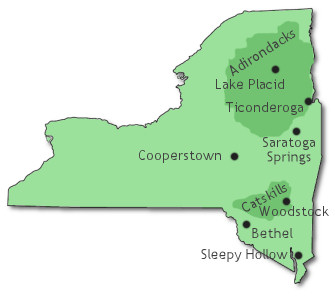
|
|
|
| With our trip to China firmly
behind us, we were looking for a short and relaxing
local outing for the approaching Memorial Day weekend.
After weighing the options, we decided that a driving
tour of Upstate New York wouldnít be too strenuous while
allowing us to see a few new sites. We established our
base of operations in a nice hotel in Albany where we
could soak in the hot tub after a vigorous day of sightseeing. |
|
|
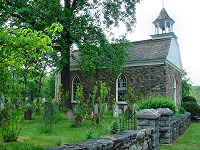
The Old Dutch Church
|
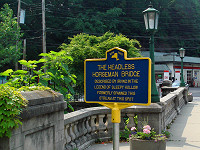
Headless Horseman Bridge
|
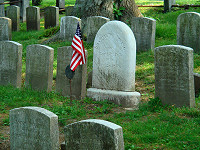
Irving's gravesite
|
|
|
In planning this trip, our
intention was to stick to the Adirondacks to do some
hiking and possibly visit the Catskills for more of
the same. But as we studied the map, the scope of
this excursion began to creep, and so it was that
we found ourselves heading to the Hudson River near
White Plains. Our first destination was the village
of Sleepy Hollow (formerly North Tarrytown) which
served as the fictional setting for Washington Irvingís
The Legend of Sleepy Hollow. While
the famed Headless Horseman Bridge spanning the Pocantico
River has long been replaced by something rather ordinary,
the Old Dutch Church and its burial ground where Ichabod
Crane took refuge is still intact. The church was
built in 1685 as a place of worship for the original
Dutch settlers, many of whom are buried in the churchyard.
Irvingís resting place is actually in the adjacent
Sleepy Hollow Cemetery as are those of Walter Chrysler,
Samuel Gompers, William Rockefeller, and the surprisingly
modest grave of Andrew Carnegie.
Crossing the Tappan Zee, we
made our way up the west side of the Hudson. We were
blessed with pleasant weather and took our time driving
the back roads, enjoying some spectacular views of
the valley. Our next stop was West Point to see what
was what. This promontory jutting out into the Hudson
is, of course, home to the US Military Academy since
1802 but has been a continuously used as a military
post since 1778. Benedict Arnold commanded the fortifications
at West Point in 1780 when he plotted its surrender
for payment and a commission in the British Army.
Today the academy occupies 16,000 acres and graduates
900 new officers a year.
When in the vicinity of a military
installation, D has this incredible talent for finding
the one road that leads directly to the main gate.
And so there we were at the guard shack with a dozen
cars behind us and a large man asking to see our ID
cards. We recovered from our faux pas and made our
way through the campus town on foot. It just so happened
to be graduation weekend, so war protestors (both
pro- and anti-) were out in force. The excitement
proved too much for us, so we headed out toward the
Catskills.
|
|
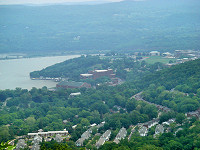
The US Military Academy at West
Point
|
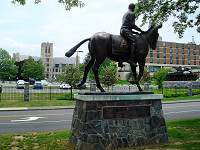
Hannibal the Mule
|
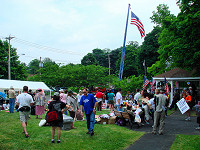
War protestors clash
|
|
|
|
The area comprising the Hudson
River Valley and the Catskill Mountains has been a
proving ground for entertainers since the days after
vaudeville. Legendary comedians honed their skills
by playing to Catskill resorts popular with Jewish
vacationers in what became known as the Borscht Belt
and the Jewish Alps. Artists and musicians found the
upstate New York particularly appealing as a rural
retreat from the pace of the City. The post-war years
saw an influx of beat poets and folk artists into
the area. Bohemian communities began to sprout up,
particularly in a small town on the edge of the Catskills
which ultimately included residents such as Pete Seeger,
Joan Baez, Tim Hardin, and Bob Dylan. In the late
60s, four twenty-somethings from New York City struck
upon the idea of building a recording studio in the
remote town of Woodstock to accommodate the increasing
number of musicians moving into the area. They also
decided to put on an extravagant concert to celebrate
the counter-culture that was developing in the area,
and consequently formed a partnership called Woodstock
Ventures to solicit funding for both projects. The
partners began their search for a suitable site in
the vicinity of I-87 and ultimately decided on an
industrial park in Wallkill which was permitted to
hold cultural festivals and looked to be an appropriate
size for the expected crowd of 50,000. As more big
names were signed to perform and interest grew, Wallkill
officials and residents grew nervous culminating in
the revocation of the permit a month before the concertís
scheduled date. Desperate for a new venue, the organizers
were put into contact with a lawyer-turned-dairy farmer
named Max Yasgur who owned a farm in Bethel, some
40 miles from Woodstock, and an agreement to host
the event was reached. The Woodstock Music and Arts
Fair ultimately attracted a crowd of 450,000 and went
on to define a generation. Yasgur spent his remuneration
on damages to his property and fighting lawsuits filed
against him by his neighbors. Today the land is part
of Bethel Woods, a state-of-the-art amphitheatre and
museum to the music of the 60s.
Visiting Bethel required us
to make a significant detour but it was well worth
the trip. We were still in a musical mood, so we made
our way back towards the town of West Saugerties to
find Big Pink. When Bob Dylan broke his neck in a
1966 motorcycle accident near his home in Woodstock,
his backup band moved into a salmon-colored house
in nearby Saugerties to work with him as he convalesced.
At Dylanís urging, the Band stepped out on their own
with a landmark album written and recorded in the
house called Music from Big Pink. The house
still remains, so we couldnít resist taking a peek.
Afternoon was rapidly becoming
evening, and we were no where near our final destination
of Cooperstown. As the sun began to fade, we took
the scenic route through the Catskills taking our
sweet time to enjoy the views but keeping one eye
on the clock. Cooperstown was founded and named for
the father James Fennimore Cooper of Last of the
Mohicans fame, but it is more famous as the legendary
site of the first game of baseball organized by Adbner
Doubleday in 1839. The story is steeped more in myth
than truth, in fact Doubleday was a cadet at West
Point at the time and eventually went on to defend
Fort Sumter at the opening of the Civil War, but it
was enough to justify it as the location for the Baseball
Hall of Fame. Our plan was to visit the HOF but it
closes at 9pm and we only pulled into town just before
8. Hereís a tip for all you Cooperstown visitors:
if you arrive at the Hall of Fame an hour before closing,
they let you in for free. Of course, the downside
of saving the $30 admission fee is that you can only
spend twenty minutes per floor to see the exhibits.
We did our best to cover as much ground as possible
but were politely escorted from the premises at closing
time.
|
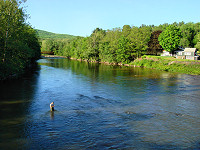
A typical Catskills scene.
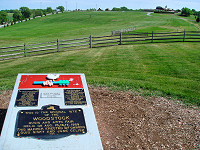
Woodstock - 38 years on.
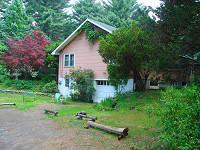
Big Pink.
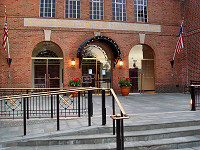
Baseball's Hall of Fame in Cooperstown.
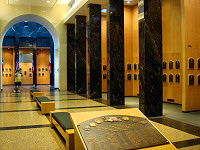
Inside the Hall.
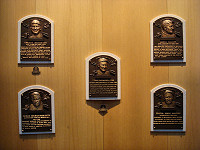
Mathewson, Ruth, Cobb, Wagner,
and Johnson - the original five inductees.
|
|
|
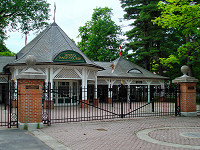
Saratoga Springs Race Course.
|
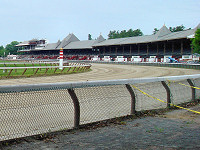
The final stretch.
|
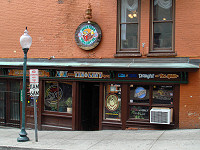
Birthplace of American Pie.
|
|
|
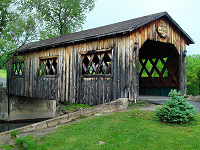
The Kissing Bridge at Ticonderoga.

Fort Ticonderoga.
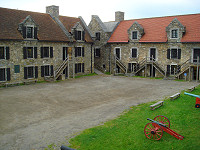
The assembly area at Fort Ticonderoga.
|
Day 2 saw a continuation of
our tripís theme of history, sports, and music. We
headed north this time to the resort town of Saratoga
Springs near the site of the pivotal Revolutionary
War battle that resulted in the surrender of 9000
British soldiers and prevented further advances by
the British from Canada. The town is best known for
its racetrack, the oldest thoroughbred race course
in the nation, and accompanying Horse Racing Hall
of Fame. We had another big day ahead of us, so we
only stopped for a quick glimpse of the racetrack
before looking around downtown. The heart of Saratoga
Springs is full of bars and coffee shops such as Caffè
Lena where Dylan and Guthrie performed early in their
careers as well as the Tin & Lint in which Don
McLean penned his classic American Pie.
Under darkening skies, we moved
along Lake George to Lake Champlain and a visit to
Fort Ticonderoga. The fort has played a role in both
the French and Indian War and the American Revolution.
Built by the French in 1757, it was had an unusual
history in that it was defended by the French against
a British attack even before the walls were finished,
but it was captured from the British during the War
of Independence without a shot being fired when Benedict
Arnold, Ethan Allen, and the Green Mountain Boys sneaked
into the garrison through an unlocked gate. Arnold
then took cannons from the captured fort all the way
to Boston to lay siege to the British occupational
forces. Reconstruction of the fort is still underway,
and there is an excellent museum displaying weaponry
from the period.
The rain began to fall as we
wound our way through the Adirondacks to our furthest
point of our day trip. Twice in the last century,
this part of New York was the focal point of the sporting
world when it was host to the Winter Olympics. Originally
slated for Big Pines, CA, the 1932 games were moved
at the last minute to Lake Placid because of the more
favorable weather conditions. Athletes like Jack Shea
and Sonja Henie dazzled the crowds during a competition
that consisted of only 14 events. By 1980, the Winter
Olympics had ballooned to 38 events and saw the likes
of Eric Heiden and Ingemar Stenmark win multiple gold
medals. One can clearly see the contrast in popularity
of the Games then and now after visiting the 1932
arena with its 2,400 seating capacity and the adjacent
Herb Brooks Arena where the 1980 US hockey team pulled
off the Miracle on Ice.
|
|
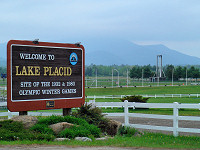
Two-time host of the Games wth
the Olympic flame cauldron in the distance.
|

Entrance to both the 1932 and
1980 Olympic arenas.
|

The speed skating oval where
Eric Heiden won five gold medals.
|
|
Copyright © 2005 JnDsTravelog.com. All rights reserved. |
| |